|
WERE THE STRINGERS IN TAMPA BEFORE THE
SEPT. 1848 HURRICANE?
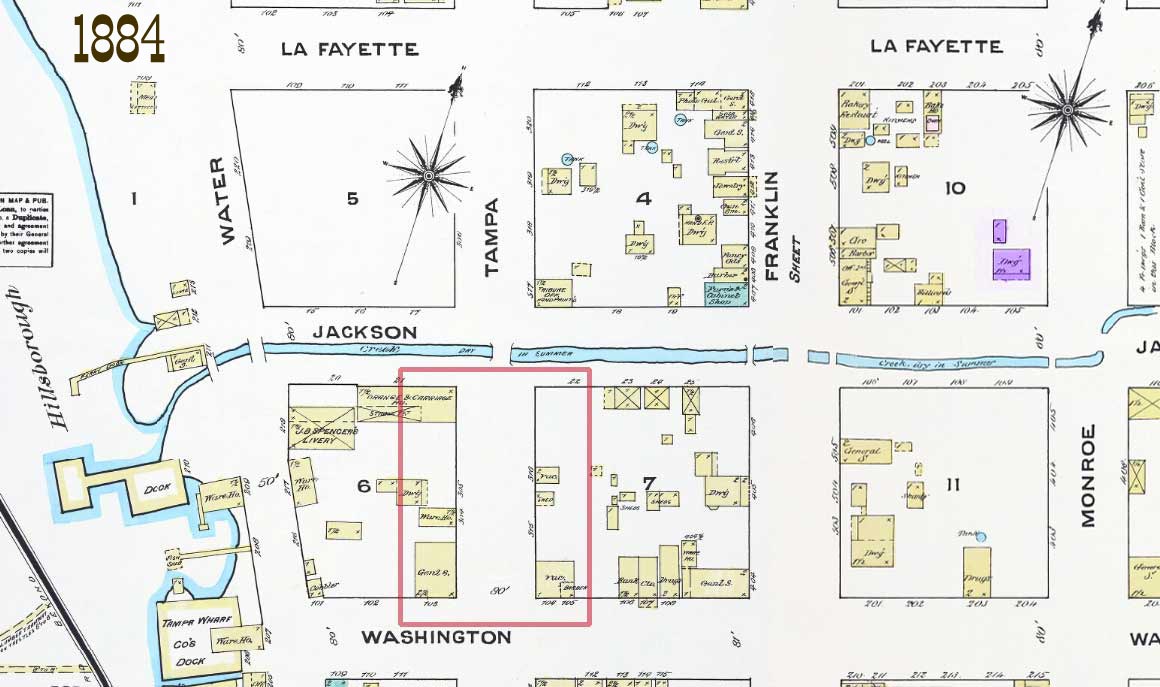
This 1884 Sanborn map
shows the area on Tampa Street between Jackson and Washington
where John Jackson's home was located in 1848. The dwelling
in purple shows the Stringer house still in existence.
Notice the proximity to the river of the location of the Jackson
home compared to that of the Stringer home. There is no
doubt that this whole area flooded.
And finally, Mary Stringer would have been around 48 years old at
the time. Thomas Jackson may have considered her to be an
elderly or old lady at the time of the storm, but Thomas claims it
was his parents who related these events to him. John
Jackson was 36 in 1848. Would he have referred to Mary as
being "elderly" or an "old lady?"
|
| IF THE HISTORIC STRINGER HOUSE WAS BUILT
BEFORE THE SEPTEMBER 1848 HURRICANE, COULD IT HAVE SURVIVED?
In "The most terrible gale ever
known" - Tampa and the Hurricane of 1848, by Canter Brown, Jr.,
he described Tampa outside of the Ft. Brooke garrison before
the hurricane:
| A few houses dotted the
landscape inside Tampa’s surveyed limits east of the river.
Among them, widow Mary Stringer occupied a dwelling where
Tampa’s city hall now stands. The A. H. Henderson family
lived on Florida Avenue at Whiting Street, while surveyor John
Jackson had erected a home on Tampa Street, between Jackson
and Washington. The Darling & Griffin store (later called
Kennedy & Darling) sat at the corner of Whiting and Tampa
Streets. East along the north side of Whiting Street near the
river (Water Street) rested the town’s principal hostelry, the
Palmer House Hotel, operated by Port Collector John M. Palmer
and his wife Margaret F. Palmer. A walk of a "few hundred
feet" north brought visitors to the L. G. Covacevich home. At
or near the foot of Lafayette Street close to the river came
Judge Steele’s former residence, a Seminole War blockhouse,
and the Simon Turman and William Ashley homes. A "trail"
connected the heart of town lying along the riverside and
Whiting Street with the remote courthouse site. |
You can read Canter Brown's entire article here in the PDF at the USF
Digital Library Collections.
Two of the sources
for Brown's article are newspaper articles. One was Thomas E.
Jackson, "Storm of 1848 Was Real Thriller, Says Thos. E. Jackson,
Pioneer Tampan, In a Letter to the Times," Tampa Daily Times,
October 18, 1924.
In this Times article,
the author uses comments by Thomas E. Jackson, a son of the first
surveyor of Tampa, former short-time mayor and merchant, John
Jackson, to corroborate details of an article about the great gale
which appeared a week earlier. Thomas was born in 1852, four
years after the hurricane. His account is by memory of what
his parents and others may have told him, and he is retelling this
over 50 years after hearing it from his parents.
THE TAMPA TIMES - Oct. 18, 1924
|
 |
|
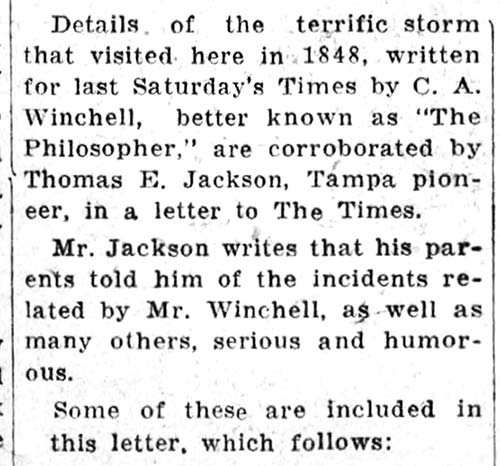
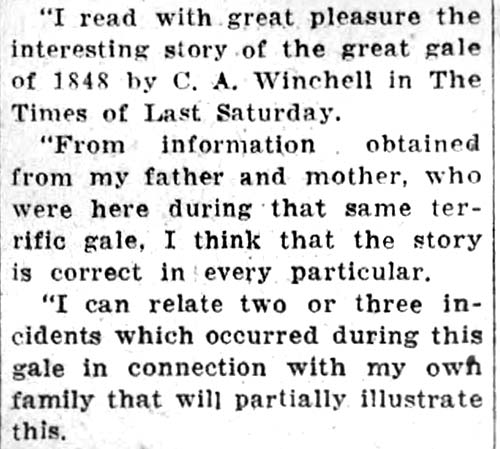 |
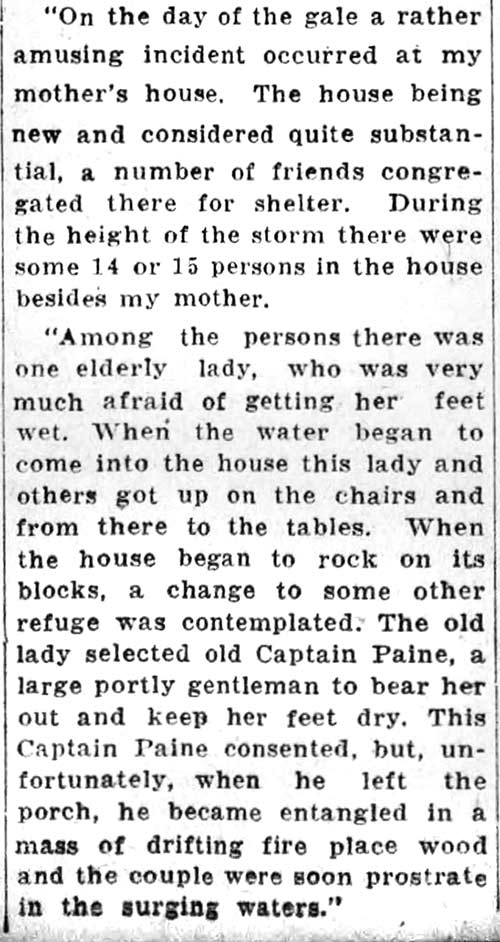 |
|
Notice that Thomas Jackson
describes the scene at his parents' house, but does not say
who the "elderly lady" was. |
This newspaper article
can be seen in its entirety
here at TampaPix. Click that newspaper article to see it full
size.
|
The article
above references an article of the previous week. That
article by C. A. Winchell describes much more of the
hurricane. His sources of the storm's details were
existing accounts by W. G. Ferris and his son, Josiah
Ferris. The article first describes Tampa before the storm,
then the details of the hurricane, then the aftermath.
|
|
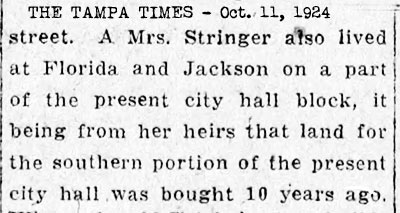
Above, the only mention of the Stringer family in that
article.
The first page of this newspaper article
can seen
in its entirety here at TampaPix. Then click the
newspaper article to see it full size.
The article concludes on a 2nd page here. |
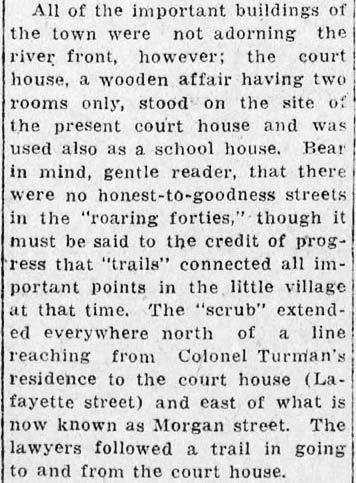 |
|
More from Canter
Brown, Jr.'s article "The most terrible gale ever known" -
Tampa and the Hurricane of 1848"
The blow
arrived in earnest at about 8:00 a.m. on Monday, the 25th.
A shift in the wind from the east to the southeast heralded
the change. That night, the bay glowed with a phosphorescent
sheen. Come Sunday morning, winds commenced gusting from the
east, followed by intermittent showers.
|
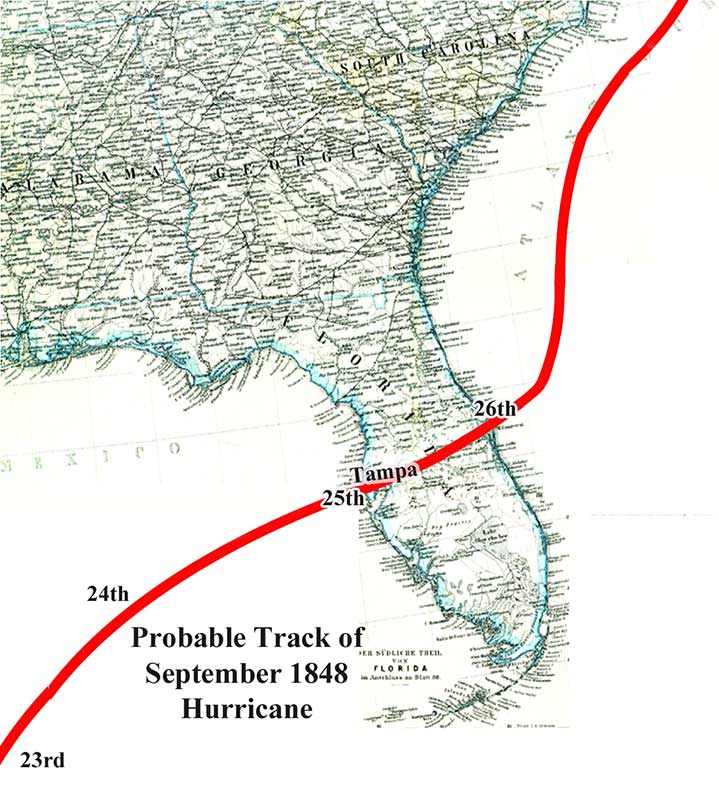 |
|
1848 map from
Exploring Florida Maps; a part of Maps ETC and
Exploring Florida websites. Produced by the Florida
Center for Instructional Technology College of
Education, University of South Florida. |
Most Tampans
failed to react quickly to the threat. As the winds grew in
intensity, they looked on from their homes as live oaks and
shrubs took the brunt of the early going. "In the morning
before the storm came to its full height," recorded an Axtell
family member, "we watched from the front windows the falling
of some of the most beautiful trees that ever graced Tampa."
Then, at 10:00
a.m. the tide commenced to rise. A young woman who endured the
storm insisted that "at one time it rose five feet in fifteen
minutes." The water quickly submerged the shore, blown toward
the post and village with terrific force by the hurricane
winds. Caught unprepared, local residents panicked, especially
those who lived near the water. "Our house was blown down in
part, and the waters from the bay swept around it in fearful
violence," declared Juliet Axtell. "We escaped from it in the
midst of the fearful tempests," she continued, "the roofs of
buildings flying round us and the tempest raging at such a
rate that we were unable to keep our feet or wear any extra
clothing such as a shawl, to protect us from the piercing
rain."
The Ferrises,
McKays, and others who did not enjoy military or
quasi-military standing headed into the village to the Palmer
House. [This was on the north side of
Whiting St. near the river.] Many arrived between 11:00
a.m. and noon to discover that "dinner" had been laid out on
tables in the hotel’s dining room. At about the time Ferris
reached safety, likely just after 1:00 p.m., the tempest
reached its full power.
An account
which suggests that a tidal surge or "wave" hurled the flood
waters to new levels, W. G. Ferris witnessed the results.
"Looking southward he saw the commissary building floating
directly towards the store, and it was apparently coming ’end
over end,’" the Ferris account related. "Part of the time it
seemed to ride the big waves, then it would sink away between
them, but all the time, and that means only a few seconds, it
rolled and tumbled straight on towards the doomed buildings.
Finally it struck the warehouse.
As the tidal
surge or wave sped the flood toward Tampa’s higher elevations,
the panic originally felt by those who resided near the water
spread generally. For example, an estimated fourteen or
fifteen persons had gathered at the newly constructed and
sturdy John Jackson home. Ellen Jackson, a bride of only one
year, made them comfortable in the absence of her husband, who
was away with a survey crew near today’s Pasco County
community of Elfers. The refugees’ sense of comfort and safety
soon proved false, however. The rising tide surged under the
house, and its waters poured into the building.
Events at the
Jackson home then proceeded at a maddening pace. One elderly
woman, likely Mary Stringer,** expressed
the terror that she felt by voicing an acute fear of getting
her feet wet. "When the water began to come into the house
this lady and others got up on the chairs and from there to
the tables," recalled son Thomas E. Jackson. "When the house
began to rock on the blocks, a change to some other refuge was
contemplated," he added. "The old lady selected old
Captain Paine, a large portly gentleman, to bear her out and
keep her feet dry." Jackson concluded, "This Captain Paine
consented, but, unfortunately, when he left the porch, he
became entangled in a mass of drifting fire place wood, and
the couple were soon prostrate in the surging waters."
Subsequently, the house floated off its blocks and "crossed
the street and bumped into three large hickory trees that
barred its way for hours."
After 2:00
p.m., the winds began slowly to subside as they shifted from
southwest to west-north-west. Still, according to Major Wade,
they "raged with great violence until past 4 P.M., after which
they lulled very much toward 8 P.M." |
**
It appears that Brown has added the suggestion that the elderly
woman in the Jackson home was "likely Mary Stringer." It is Thomas
Jackson who first describes the frightened woman as an "elderly
lady" and "old lady" but doesn't identify her. Would
Thomas' mother have described Mary Stringer as an elderly or old
lady at age 50 or so? No mention is made by Jackson of
Mary's children escaping the Jackson house; Sheldon would have
been around 13, Laura around 11, and if Samuel was there, he would
have been 17. It is doubtful that Mary would have left her
house to take refuge in another house without her children. If she
was in the Jackson home with her family, it probably would have
been because the Jackson home was thought to be sturdier.
But the Jackson home, at Washington and Tampa Streets, was closer
to the bay and the river and would have flooded from the tidal
surge before the Stringer home. Would Mary have left her
house to go to one closer to the flooding?
|
|
The Great Gale of 1848 at Wikipedia
The 1848 Tampa Bay hurricane,
also known as the Great Gale of 1848, was the most severe
hurricane to affect the Tampa Bay area and is one of only
two major hurricanes to make landfall in the area, the other
having occurred in 1921. It affected the Tampa Bay Area
September 23–25, 1848, and crossed the peninsula to cause
damage on the east coast on or about September 26. It
reshaped parts of the coast and destroyed much of what few
human works and habitation were then in the Tampa Bay Area.
Although available records of its wind speed are
unavailable, its barometric pressure and storm surge were
consistent with at least a Category 4 hurricane. A survivor
called the storm "the granddaddy of all hurricanes."
The storm appears to have
formed in the central Gulf of Mexico before moving northeast
to make landfall near Clearwater, Florida. It then crossed
the Florida peninsula and exited near Cape Canaveral.
After moving into the extreme western Atlantic, the cyclone
continued to the northeast just offshore of the East Coast
of the United States to the Grand Banks of Newfoundland.
Fort Brooke recorded peak
winds of 72 miles per hour, and a barometer at the fort
measured a minimum pressure of 28.18 inches of mercury (954
mb), though the winds were still blowing at the time that
reading was made. The storm produced the highest storm tide
ever experienced in Tampa Bay. The water rose and fell about
15 feet in six to eight hours. The tide inundated Pinellas
County “at the waist,” covering all low-lying elevations,
and reportedly submerged most of the Interbay Peninsula,
where South Tampa and MacDill Air Force Base currently
reside. “The bays [Hillsborough and Old Tampa] met.” General
R. D. A. Wade, commanding at Fort Brooke, reported the
destruction of the wharves, public buildings, and
storehouses. B. P. Curry, the fort’s assistant surgeon,
reported the hospital destroyed. Only five houses were left
standing in Tampa, and they were all damaged. The water rose
twelve feet higher than had been noted in the past, and
strong winds downed many old trees.
On the Pinellas Peninsula,
the storm destroyed the fishing rancho of Antonio Máximo
Hernández, reputedly lower Pinellas’ first white settler,
forcing him to emigrate permanently. The storm almost
obliterated the citrus crop and destroyed the main house at
St. Helena plantation—now part of Safety Harbor—forcing the
residents to shelter on an elevated Tocobaga mound. Even so,
they nearly drowned as the storm tide eroded part of the
shell mound. Winds also felled almost all of the trees along
what is now Indian Rocks Road in Largo.
The storm completely
altered the coastal geography of the Tampa Bay area, cutting
new inlets, filling in others, and altering the shape of
bays and keys, thereby making navigational charts useless to
mariners. Allen’s Creek was widened from less than 200 feet
to about half a mile at its mouth. Passage Key, between
Egmont Key and Anna Maria, was obliterated but reformed
later. The storm created what would become known as
“Soldier’s Hole” at Mullet Key, so called because soldiers
at Fort De Soto used it as a swimming hole. John’s Pass was
opened but has since shifted north. After the storm
destroyed the lighthouse on Egmont Key, the keeper (Marvel
Edwards) rode out the storm in a rowboat tied to a palmetto
tree. The end of the rope was later found 9 ft. off the
ground, which had an elevation of about 6 ft.
|
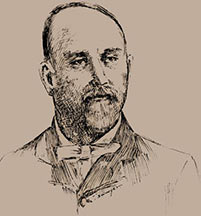
By James McKay,
Jr. in "Reminiscences
- History of Tampa in the Olden Days" Dec. 18,
1923 and "Oldest Tampa Citizen Recounts Tampa's Deeds,"
Dec. 20, 1921, Tampa Times.
In 1848, the town was visited
by a terrific hurricane causing the tide to rise above 15
feet above low water mark, washing away the W. G. Ferris
store and the house we were living in; in fact, most of the
houses that were located on the river bank.
At this time, my father was
absent at New Orleans with his schooner, the Wm. H. Gotzmer,
this vessel at that time being the only means of
transportation with the outside world in securing supplies
for the small colony of Tampa.
Our family was moved to the
Palmer hotel, and when driven out of there on account of the
tide, to the Darling and Griffin store, and then to the
military hospital on the reservation.
The Palmer Hotel withstood the hurricane, although the water
rose two feet over the main floor.
After the hurricane, the
military authorities issued my mother tents to house our
family, which, with their assistance, was placed on the
block now occupied by the Knight & Wall Hardware Co., that
block at the time being owned by my grandmother, Sarah Cail.
When my father returned
in his vessel, he had some logs cut and hauled in and a
house built, where we lived for some 20 months, until he
could bring lumber from Mobile and build a house on the
block now occupied by the Almeria Hotel.
As soon as Mr. [W. G.]
Ferris could
obtain material he erected a small building on the south
side of Whiting street near the intersection of Franklin,
which did not extend farther south, on account of the
reservation.
A few years later Mr. Ferris,
having some trouble with the military officials, was ordered
off the reservation, so he moved his store to the corner of
Florida and Washington streets and built his residence on
the same lot. This residence became the old folks home and
later on was moved to the site the home is now occupying and
somewhat improved, or made larger.
(See this house) |
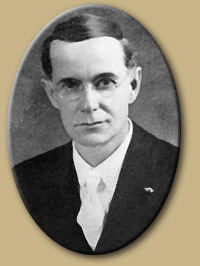 E.
L Robinson's account of the storm: E.
L Robinson's account of the storm:
The turbulent
weather preceding the great storm of 1848 commenced on
Saturday, September 23. During Sunday the wind came in gusts
from the east accompanied by occasional showers. A number of
men went down the bay on Sunday to assist in bringing in W.
G. Ferris' schooner, the John T. Sprague, due from New
Orleans with a cargo of supplies. Great difficulty was
experienced in towing the vessel against the strong wind,
and it was necessary to "kedge" (move by hauling in a thick
rope or cable attached to a small anchor dropped at some
distance) more than once before reaching the landing. It was
well for the troops and villagers that this cargo was saved,
for it was some time afterward before more supplies came in.
The schooner also brought specie (coins) and currency to be
paid to the soldiers, Mr. Ferris being "acting'' paymaster
at the time.
On the
morning of the 26th, the wind shifted to the south and
finally to the southwest. Then the trouble commenced.
A high tide came in, and the velocity of the wind increased,
driving the water deep into the garrison. Ferris carried his
family to the Palmer House, then waded ·in "water up to his
armpits back to the store, where he succeeded in getting out
the currency and account books. Then upon looking southward,
he saw the commissary building rolling and tumbling straight
toward his warehouse. A moment later there was a crash as
the warehouse was struck and away went the whole structure,
reduced to a mass of wreckage that included $15,000 worth of
goods and a large amount of specie.
The Palmer
House now seemed doomed. Tables began to float around in the
dining room of the old hostelry. Josiah Ferris, son of the
sutler, distinguished himself by swimming out through the
north door with a young girl in his arms. The refugees
retreated to the Kennedy store, thence to still higher
ground at the corner of Franklin and Washington. But the
Palmer House withstood the storm. The scene in the garrison
was now appalling, though sublime in its grandeur, as the
great waves came charging in, and the bay as far as the eye
could reach was lashed to a fury. The islands in the bay
were out of sight under the water, and the tidal wave rushed
across the peninsula west of the river into Old Tampa Bay.
The tremendous pressure of wind and water raised the river
until only the treetops were visible, far north of the
village. The Sprague, with the government specie still on
board, had been anchored up at the ship yard," and during
the worst part of the gale the hull of an old abandoned boat
floated against her and broke her cables, allowing her to
drift out into the pine woods east of the river and
somewhere west of what is now Franklin street with captain
and crew still on board.
During
Monday afternoon the wind died away and the waters receded
somewhat, giving the villagers an opportunity of viewing the
damage. In the garrison they found that the little church on
the beach, the soldiers' quarters near by, C. B. Allen's
boarding house, the Indian agent's office and the Ferris
property had been wrecked, and all other buildings in that
locality more or less damaged. North of Whiting street, the
block house and the Turman and Ashley residences had been
swept away. The roof of W. S. Spencer's house was blown off.
The residence of Capt. James McKay, Sr., was spared.
|
|
On Tuesday
morning the men from the Sprague came down out of the woods
and brought some coffee, hard bread and other needed
supplies. Learning that the food on the vessel was intact,
the commander at the fort sent a detail of soldiers to bring
the supplies to the village and these were divided between
the storekeeper and the troops. Later, the government paid
for these confiscated goods. Ferris' stock was scattered all
the way from Sulphur Springs to Gadsden Point. Several days
later the strong box was recovered by the sutler, the specie
(coins) intact.
Whiskey flowed freely on the evening following the gale,
several barrels of the potent stuff having been salvaged
from the bay and river. Most of the liquor as well as a
number of cases of wine was turned over to the post
commander, however. A number of cedar logs which
Ferris had kept in a "bight" on the Alafia river were
scattered along the shore from a point up the river around
to the north shore of Old Tampa Bay. It is said that the
waters of the bay were phosphorescent during several nights
preceding the gale, and on Sunday night the light from this
source was "almost bright enough to read by."
The village
school, taught by a Mr. Wilson, had been dismissed on the
forenoon of the day of the gale, and Mr. Henderson, who was
one of the pupils, said that the velocity of the wind was so
great the people were forced to hug the ground in order to
get anywhere. During the storm the lighthouse at Egmont was
so badly damaged that a new one was built. No lives were
lost as a result of the gale, but there were many narrow
escapes from death. As to the cause of the inundation,
various theories were advanced. Many were of the opinion
that the east wind had blown great volumes of water into the
gulf, and that the south wind coming on with the tide, drove
the waters of the overtaxed gulf into the bays along our
coast. Of such was the memorable storm of '48.
History of Hillsborough County, Florida, Narrative
and Biographical, 1928" by Ernest L. Robinson,
Director of High Schools of Hillsborough County, Formerly
Principal of
Hillsborough County High School. |
|